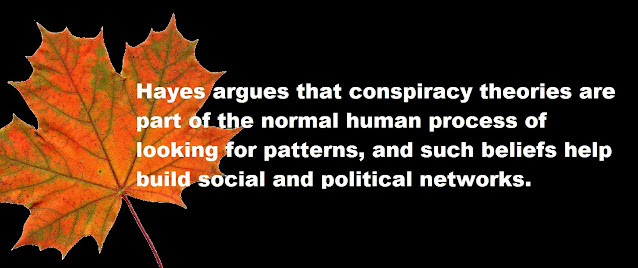This makes a change from most UFO books as it explores the interaction between civilian UFO believers and government agencies. This is conducted by charting the history of Canada’s official UFO research and how different agencies dealt with questions from the public.
🔻The first few pages show a fair selection of UFO reports with illustrations that were sent to Canadian authorities. Some are sketches of typical flying saucer craft with diagrams and maps of their flight paths, there is one that is a ‘copy’ of the mothership in Close Encounters of the Third Kind, another shows two orbiting electrons inside a coffin-shaped craft, the most amusing shows strange creatures who hypnotised the witness who writes that they were seen under the influence of hash, beer and rum. No wonder most officials regarded UFO reporters as cranks or at least victims of misidentifying mundane natural phenomena.
The worldwide press coverage of Kenneth Arnold’s sighting of flying saucers, led to similar sightings being reported throughout Canada. There was no central government organisation that collected these reports, instead they went to different agencies and departments. Hayes gathered 15,000 pages of documentation for this study from 5 different departments. Most of the documents consisted of sighting reports, and between 1949 and 1995 there were 4,500 unique sightings.
What was frustrating for civilians wanting to know more about the Canadian UFO files was that not only was there no central agency to contact but the different departments had very little communication between each other. This led to enquirers getting the runaround from one department to another and in the process often received contradictory answers.
The first official study was initiated by Wilbert Smith, an electrical engineer at the Department of Transport. His Project Magnet ran from 1950 to 1954, and as its title suggests it concentrated on Smith’s theory that UFOs operate using geomagnetic energy. It was mainly Smith’s baby and when it got too much publicity, due to being highlighted by Donald Keyhoe in his 1953 book Flying Saucers from Outer Space, its official funding was withdrawn.
Project Second Storey, was operated by the Defence Research Board from 1952 to 1954 and consisted of an advisory committee of scientists and military officials. Rather than understand and perhaps copy the operating principles of UFOs which was the guiding principle of Project Magnet, this project had a more sceptical position and basically wanted to debunk sightings in order to fight the irrational and uneducated belief in UFOs.
After 1954, the government passively collected UFO reports but no investigations were carried out. In the meantime, to fill the vacuum, civilians set up their own UFO clubs and investigations, and increasingly they felt that the government was keeping UFO secrets from them.
It was only in 1967 that three cases occurred that seemed worthy of official investigation because they offered the chance of examining physical evidence. These consisted of Stefan Michalak’s Falcon Lake close encounter, the Duhamel, Alberta crop circles and the Shag Harbour crash case. Each proved problematic, although Michalak had a grid-shaped burn on his chest he was evasive about the landing location; the ‘crop circles’ were regarded as a hoax but how the the deep impressions in the ground were made was never discovered; as for Shag Harbour, a 60ft diameter object with four lights was seen by credible witnesses splashing into the water but a diving team was unable to find anything.
After 1967, behind the scenes, there was no government cover-up, instead there was just confusion about who should be responsible for investigating cases. No department wanted this hot potato. The Department of National Defence (DND) having dismissed UFOs as a security threat as early as the 1950s, did not want to imply by association that UFOs were a public danger. Rather grudgingly the National Research Council (NRC) took over responsibility at the end of 1967. A DND official noted the ‘...NRC staff members concerned appear to be personally convinced that UFO sightings do not merit serious attention.’
So many sightings were explained by the NRC as meteors that they produced a special stamp for marking sighting reports, this had the wording ‘Identified as a Meteor’, later changed to ‘Identified as Possible Meteor.’ The lack of interest, retirements and budget cuts led to the termination of this lacklustre effort by the end of 1995.
The secretive nature of the Canadian government and the lack of a coherent approach to the subject led citizens to demand, sometimes in a rude fashion, answers. As Hayes notes: "The government’s position on the unreality of UFOs and extraterrestrials hardened, whereas the citizen activists turned to conspiracy theories to explain the state’s unwillingness to engage."
It is easy to ridicule conspiracy theorists but Hayes is careful to explain that this was in part due to the increasing lack of trust in the government in the 1960s, the call for greater transparency and the dismissive attitude of government departments. Hayes argues that conspiracy theories are part of the normal human process of looking for patterns, and such beliefs help build social and political networks. In the context of the perception of Canadian government UFO research, and how they dealt with the subject, it was no wonder people believed they were covering up ET evidence.
Although this is based on a PhD dissertation and has copious notes, this is a very readable account of the response to UFOs in the shadow of the USA. The only thing lacking is the mention of the secret Avro Canada projects that attempted to build flying saucer-like VTOL aircraft, which must have helped fuel Canadian conspiracy theories during the Cold War.
- Nigel Watson



No comments:
Post a Comment